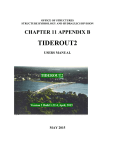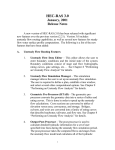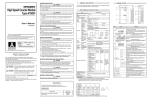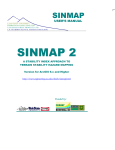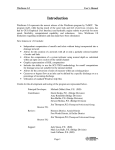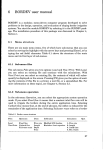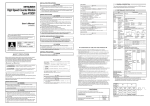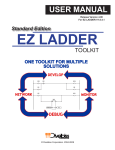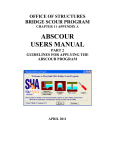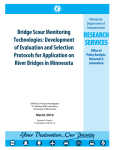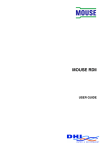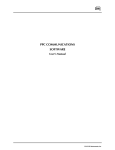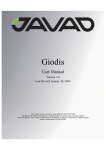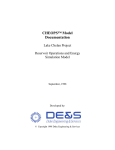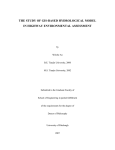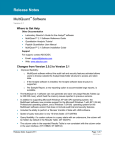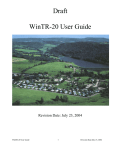Download office of structures manual for hydrologic and hydraulic
Transcript
OFFICE OF STRUCTURES MANUAL FOR HYDROLOGIC AND HYDRAULIC DESIGN CHAPTER 11 APPENDIX B TIDEROUT 2 USERS MANUAL APRIL 2011 APRIL 2011 Page 1 Preface TIDEROUT 2, Build 1.22 dated June 29, 2006 is the current version of this program and all previous versions should be discarded. The user is advised to check the web site below for any revisions to the program: http://www.gishydro.umd.edu The material presented in this TIDEROUT 2 Users Manual has been carefully researched and evaluated. It is periodically updated and improved to incorporate the results of new research and technology. However, no warranty expressed or implied is made on the contents of this program or the user’s manual. The distribution of this information does not constitute responsibility by the Maryland State Highway Administration or any contributors for omissions, errors or possible misinterpretations that may result from the use or interpretation of the materials contained herein. TIDEROUT 2 is a flood routing program. Its primary purpose is to serve to estimate scour at bridges in tidal waterways. It can be used to route riverine flows from an upland watershed down to the tidal basin and then route the combined riverine/tidal flow through the bridge (and perhaps over the road) down to the sea: Basic equation: Inflow – Outflow = Storage Bridge flow/roadway overtopping flow = tidal flow + riverine flow Many newly designed OBD tidal bridges span wetlands and do not constrict tidal flow so as to cause significant contraction scour; contraction scour may be more of a problem with older structures that do constrict the waterway area. The advantages of the TIDEROUT program include: 1. Takes into account conditions of unsteady tidal flow 2. Evaluates potential benefits of storage in the tidal basin upstream of structure 3. Provides a means of combining riverine and tidal flow hydrographs to estimate the worst case scour condition 4. The user can very quickly change input parameters to do sensitivity testing of reasonable combinations of storm tides, riverine flow, wind conditions, etc. to find the worst case scour. The limitations of the TIDEROUT 2 program include: 1. Method does not address other aspects of tidal flow such as littoral drift or movement of sediment through the tidal basin. 2. Method cannot be used for complex tidal currents resulting from flows between islands where wind forces predominate APRIL 2011 Page 2 3. User needs to manually compute contraction and local abutment scour 4. User needs to import TIDEROUT2 output into ABSCOUR to compute pier scour. Introduction Chapter 10, Appendix A, Hydraulics of Tidal Bridges, provides a comprehensive discussion of various aspects of the hydraulic design of tidal bridges. The user of the TIDEROUT 2 program is encouraged to become familiar with the guidance in Chapter 10, Appendix A before conducting a tidal analysis at a bridge. The user needs to recognize that unsteady tidal flow is complex, and that TIDEROUT 2 provides for simple hydraulic and scour models to evaluate it. Nevertheless the program can be used effectively in the design of structure foundations to evaluate and determine worst-case scour conditions. Tide Models The Office of Structures currently uses TIDEROUT 2 and HEC-RAS to analyze tidal flow at a bridge. Two dimensional flow models are useful for evaluating flow in large estuaries, but are not considered necessary for the typical SHA tidal crossing. The SHA guidance is geared towards tidal areas tributary to the Chesapeake Bay. Special studies may be necessary for estuaries discharging directly to the ocean. The following guidance is provided with regard to selection of a tidal model for Chesapeake Bay estuaries. Most likely, a typical bridge site will not exhibit the clear-cut categories listed below and judgment will be needed to select the most appropriate model. In some cases, it may be helpful to use both models, compare the results and then select the most appropriate results Tidal crossing in close proximity to the bay (Tide elevations control downstream tailwater elevations) Tidal crossing at a considerable distance from the outlet to the bay. (Downstream tailwater controlled by normal depth (Manning) considerations Small riverine discharge; tidal flow predominates Large upland drainage basin, riverine discharge predominates APRIL 2011 TIDEROUT 2 X HEC-RAS X X X Page 3 BOUNDARY CONDITIONS FOR TIDEROUT 2 Tidal flow is complex, especially if a combination of riverine and tidal discharges is to be used in the analysis: Assumptions need to be made about the time of the occurrence of the peak tidal flow and the peak riverine flow. If the upland drainage area is large, and the time of concentration of the riverine flow is long, it may not be reasonable to assume that the tidal flow and riverine flow peaks will coincide. The TIDEROUT 2 model can be adjusted to account for the occurrence of peak tidal and riverine flows at different times. In low-lying tidal basins (particularly on the Eastern shore) the tidal basin boundary elevations may be at four feet or less while the storm tide elevations may be at six feet or more. Careful analysis is needed to decide the proportion of the flows going through the bridge, over the road, and across the drainage divide to other watersheds. FEMA maps which are commonly used to define peak storm tide elevations are based on the NGVD datum of 1929 while SHA current project mapping is based on NAVD datum of 1988. The user will need to convert tidal data from the NGVD datum to NAVD datum when using the program (See Chapter 10, Appendix A) Various other factors, such as the wind, may influence the flow through the bridge. Please refer to Chapter 10, Appendix A for a discussion of these factors. INPUT DATA FOR TIDEROUT 2 Typical input values are described below. The user may wish to select other values depending on the issues to be addressed. APRIL 2011 Page 4 PROJECT DATA TIDEROUT 2 opens to the Project Data Card. This card has the following characteristics: 1. TOOL BAR File – File management including accessing and saving TIDEROUT 2 files. Run – Run the program Draw- Draws a schematic of the output results Tools – Utility tools for quick calculations Help – Help menus to answer questions about the program F-1 (Short Help) – Help for any input window can be obtained by placing the cursor in the input field (window) and clicking on the F1 Key 2. TAB BARS A. PROJECT DATA Project: Describe the highway and the estuary being crossed; include information on particular aspects of the study i.e. flood discharges, referenced tidal station, etc. Unit option: SHA prefers English units Analysis starting time: For the Chesapeake Bay the storm tide period is assumed to be 24 hours. Typically, the worst case scour is expected to occur during the 12 hour ebb tide period starting when the tidal basin is full (high tide) and at the elevation of the design APRIL 2011 Page 5 storm tide (time 0 hours) and ending when the basin has emptied (time 12 hours) Analysis ending time 12 at low tide Time step – See F1 Starting bridge headwater elevation – High tide elevation of the design storm tide or See F1 guidance Tide amplitude – See F1 Tidal period – Default value is 24 hours Tidal peak time (hrs) is Zero Please click on and read the Disclaimer button STREAM FLOW DATA APRIL 2011 Page 6 STREAM FLOW OPTION: The User has two options with regard to stream flow data. The objective is to get a conservative, yet reasonable, model combining tidal flow and riverine (stream) flow that includes the peak tidal flow and the peak riverine flow. Given Hydrograph: A conservative approach would be to arrange the time of a riverine hydrograph to peak at the same time as the tidal hydrograph peaks (usually time zero). Judgment is needed to decide whether it is reasonable to assume that the time of concentration of the riverine hydrograph will coincide with the peak tidal hydrograph. Constant Discharge: A second option is to convert the riverine hydrograph to a hydrograph with a constant discharge. The height (discharge) of this rectangular hydrograph is determined by dividing the total area (runoff volume) under the hydrograph by the length of the hydrograph base. This approach has the advantage of combining tidal and riverine flows when the relative timing of peak flows is problematical. CONSTANT FLOW DISCHARGE: If the constant discharge option is selected, input the value of the computed constant flow discharge; otherwise leave this field blank. STREAM FLOW HYDROGRAPH: If the stream flow hydrograph option is selected, there are two ways of inputting the data: If a hydrograph has already been developed as a part of a project study, it can be manually input here The user can also click on the generate hydrograph button to obtain a TR-20 single area model. A window is presented to input the hydrograph characteristics. We note that the TR-20 peak factor constant is 484 for all of the physiographic regions in Maryland except for the Eastern Shore which is 284. The time step selected in normally 0.1 to 0.2 hours to be consistent with the tidal hydrograph. The user can “shift” the stream inflow hydrograph so that the peak riverine discharge coincides with the peak tidal flow elevation at time zero, or with any other tidal flow elevation or discharge. For example, assume that the time of concentration of the riverine hydrograph peak occurs at time 19 hours and the user desires to shift the hydrograph so that this peak occurs at time zero for the tidal hydrograph. This is accomplished in the following manner: (1) compute the hydrograph and then (2) adjust the hydrograph time/discharge pairs for each time unit to shift the hydrograph peak to the desired time. In the example presented above, the hydrograph would need to start at time -19 hours so that the peak flow would occur at time zero. APRIL 2011 Page 7 TIDE BASIN DATA The user creates a storage area rating table for the tidal basin upstream of the bridge using the Tidal Basin card. Beginning with the elevation of the channel bottom at the bridge (usually a negative value below zero), the information is provided as a set of elevation-area pairs. The areas corresponding to the elevations can be obtained by measuring the areas between successive contour lines (See F-1 help). The upper limit of the rating table should be selected as an elevation above the design storm tide elevation. The area contained within a given contour line can be measured with a planimeter or can be computed using appropriate software (i.e. GIS Systems, CADD Programs, topographic digital elevation models, etc.) APRIL 2011 Page 8 BRIDGE WATERWAY OPENING DATA Discharge Coefficient: Refer to F-1 Help. For small bridges, the default value has been selected as 0.6. For larger bridges, particularly those with streamlined abutments, a more reasonable value would be 0.8 Bridge Waterway Area Opening Rating Table. The waterway area rating table is provided by the user as a set of elevation vs. waterway area pairs. See F-1 Help. The waterway area for various water surface elevations can be measured from the bridge plans. APRIL 2011 Page 9 ROADWAY DATA Weir Flow Coefficient: See F-1 Help Roadway Profile Ascending Station Order: See F-1 Help. Boundary Conditions: This roadway data card represents a very important boundary condition for evaluating tidal flow through the bridge. For many Eastern Shore bridges, roadway elevations will be below storm tide elevations, and a large quantity of the tidal prism will flow over the road instead of through the bridge. Similarly, if the watershed boundaries for the tidal basin are lower than the peak storm tide elevations, it may not be possible to estimate the peak tidal flows through the bridge. For this condition the recommended approach is to input an extended roadway length at the watershed overtopping elevation. This will serve to define the flows through the bridge as those flows below the elevation of the watershed divide. APRIL 2011 Page 10 PROGRAM OUTPUT The output consists of two parts: (1) a summary of the information input to the program by the user and (2) a time sequence of the changing hydraulic characteristic of the flow during passage of the selected tide and riverine hydrographs. OUTPUT PRINTOUT PART 1 – SUMMARY OF USER INPUT APRIL 2011 Page 11 APRIL 2011 Page 12 OUTPUT PRINTOUT PART 2 – TIDEROUT COMPUTATIONS APRIL 2011 Page 13 OUTPUT RESULTS – SKETCHES Elevation vs. Bridge Opening Area. Elevation vs. Basin Surface Area APRIL 2011 Page 14 Tidal and Riverine Hydrographs (For this case the user selected a riverine hydrograph with a constant discharge) Headwater-Tailwater Relationships at Bridge (Note that the velocity of flow thorough the bridge is highest When the head differential across the bridge is greatest) APRIL 2011 Page 15 SCOUR COMPUTATIONS FOR TIDAL BRIDGES HEC-RAS TIDAL COMPUTATIONS. Two flow conditions should be checked for each combination of riverine and storm tide discharges to be evaluated: 1. The riverine discharge with low tide elevation. 2. The combination of riverine and maximum storm tide discharges at mid-tide elevation.( Note that the maximum storm tide discharge can be estimated as: Q max = 3.14 VOL T Where VOL = volume of water in the tidal prism between high and low tides, and T = tidal period (selected as 24 hours for the Chesapeake Bay) 3. The HEC-RAS results can be used as input to ABSCOUR 9 to develop an evaluation of scour at the bridge. TIDEROUT SCOUR COMPUTATIONS The clear water scour equation (Refer to the ABSCOUR 9 Users Manual in Chapter 11) is used to estimate scour from the TIDEROUT 2 output tables: A portion of the table depicting flow through the bridge vs. time is excerpted below: APRIL 2011 Page 16 Please note that the highest flow velocity of 6.9 fps occurs at time 7.6 hours (underlined row above) when the downstream tide elevation is at an elevation of 0.84 feet. The channel bed elevation is at -6.8 feet, so the downstream flow depth is computed as 7.6 feet. Surface and subsurface (boring) samples indicate that the channel bed is comprised of a medium sand with a D50 of 0.0016 feet. Clear Water Scour Equation The values of vo (6.9 fps) and yo (7.6 feet) are known values obtained from the TIDEROUT output tables and the value of y2 is the total scour depth we wish to calculate. This missing variable is Vc, the critical velocity of the sand which can be obtained from the chart below excerpted from the ABSCOUR 9 Users Manual For a flow depth of 7.6 feet and a particle size of 0.0016, the critical velocity of the sand is estimated as 3.6 fps. Solve the equation for y2 (total contraction flow depth including flow depth) • q = Vo*yo = Vc*y2; then APRIL 2011 Page 17 • y2 = q/Vc = (Vo/Vc) *yo = (6.9/ 3.7) * 7.6 = 14.2 ft Contraction scour depth ys = y2 – yo= 14.2 – 7.6 = 6.6 (say 7) feet Total Abutment Scour Depth (y2a) • y2a ~ 1.4 * y2 = 1.4 * 14.2 = 19.9 ft 6 Abutment scour (ysa) ysa = y2a – yo = 19.9 -7.6 = 12 feet. The estimates of 7 feet of contraction scour and 12 feet of abutment scour should be evaluated in the context of the Office of Structures policies in Chapter 11 to determine the appropriate design for the bridge abutments. If the bridge foundations include a pier in the waterway, the above information can be input in the pier module in ABSCOUR 9 to compute the pier scour. APRIL 2011 Page 18


















